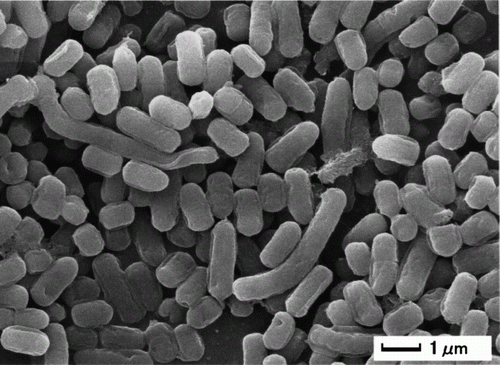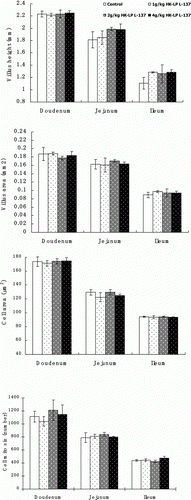Abstract
A total of 48, 7-day-old male broiler chickens were fed 0, 1, 2 and 4 mg/kg dietary heat-killed Lactobacillus plantarum L-137 (HK-LP L-137) on growth performance and intestinal histology. Feed intake was increased in 2 and 4 mg/kg HK-LP L-137 groups (p<0.05), and body weight gain of these groups was better than the control. Intestinal villus height, villus area, cell area and cell mitosis numbers in the duodenum, jejunum and ileum did not show a difference among groups. On the epithelial cells of the intestinal villus apical surface, many protuberated cells were observed in all intestinal segments of the 2 and 4 mg/kg HK-LP L-137 groups, suggesting that the epithelial cells might hypertrophy in the 2 and 4 mg/kg HK-LP L-137 groups. Many segmented filamentous bacteria were appeared in all the HK-LP L-137 groups than the control, suggesting that the immune system would be activated by HK-LP L-137. These morphological results suggest that the present 2 and 4 mg/kg HK-LP L-137 might activate intestinal function by increasing segmented filamentous bacteria, inducing a little better body weight gain.
Introduction
Immense chemical medicines have been used to prevent animal pathogens and disease in the animal industry. However, the drug residues in the animal body (Burgat Citation1991), imbalance of normal microflora (Andremont Citation2000) and development of drug-resistant bacteria (Sorum and Sunde Citation2001) have induced by continuously used dietary antibiotics. As a result of these problems, it has become necessary to develop alternatives to enhance the animal physiological functions through the use of probiotics such as Lactobacillus.
After reporting of increased growth rate in broilers fed a Lactobacillus culture (Tortuero Citation1973), similar improvements on the growth performance have been confirmed by many researchers (Han et al. Citation1984; Kalbande et al. Citation1992). Adversely, several other workers reported no difference in body weight gain after given the Lactobacillus culture diets (Watkins and Kratzer Citation1983Watkins and Kratzer Citation1984; Maiolino et al. Citation1992). Inconsistent results of using these Lactobacillus culture may be due to differences in the preparing methods and/or life and death of them during passage through the stomach and proliferation in the intestine.
Lactobacillus plantarum L-137 (HK L137®; House Wellness Food Corporation, Hyogo, Japan) is consumed as a component of fermented rice and fish dishes: cooked and cooled rice is combined with cleaned, eviscerated, sliced and salted fish; these are mixed and packed in tightly covered jar, and then fermented at ambient temperature for 7–10 days. The L. plantarum L-137 is a gram-positive and catalase-negative bacterium, and has ability to produce amylases and hydrolyse starch (Olympia et al. Citation1992). To obtain constant results, we tried to heat-kill the L. plantarum L-137, and 20% of heat-killed L. plantarum L-137 was mixed with 80% dextrin, and processed into a fine powder (HK-LP L-137).
The HK-LP L-137 has been reported to have potential ability to suppress naturally fed antigen-specific immunoglobulin-E production by stimulation of interleukin-12 production in mice (Murosaki et al. Citation1998), and to augment acquired immunity (Hirose et al. Citation2006). Besides, the HK-LP L-137 induced antitumour effect of the HK-LP L-137 through restoration of impaired interleukin-12 production in tumour-bearing mice (Murosaki et al. Citation2000) as well as enhancement of protection against influenza virus infection by stimulation of type I interferon production in mice (Maeda et al. Citation2009). Enhancement of these immune functions seems to be important to promote animal health by stimulating intestinal function. Because the intestinal function acts to animal health by many kids of physiological functions through immune and by preventing mucosal infection and disease. However, no effects of the HK-LP L-137 on the intestinal histology have found.
Also sugarcane extract has immunological effects. The sugarcane extract possessed adjuvant (El-Abasy et al. Citation2003b) effects due to immunostimulation and protective effects against Eimeria tenella infection (El-Abasy et al. Citation2003a) in chickens, and enhanced immune responses in sublethally X-ray irradiated chickens (Amer et al. Citation2004). Actually, the dietary sugarcane extract could hypertrophied intestinal histology (Yamauchi et al. Citation2006). This suggests that the HK-LP L-137 also would affect on intestinal histology. In this study, growth performance and histological alterations of the intestinal villi and epithelial cells were measured in chickens fed the dietary HK-LP L-137 diets.
Materials and methods
Animal and feeding experiments
A total of 48 7-day-old male Marshall Chunky broiler chickens were used in a growth performance trial with four treatments and four replicates of three chicks each. The birds were housed in wire pens under daily lighting regimen of 24 h of light and environmental room temperature. A conventional starter and finisher mash diets were fed from 7 to 21 and 22 to 49-day-old, respectively as a basal diet (Nichiwa Sangyo Co., Ltd., Kagawa, Japan) (). The basal diets were supplemented with 1, 2 and 4 mg/kg dietary HK-LP L-137. shows scanning electron microscope of HK-LP L-137. Feed and water were allowed ad libitum access throughout the feeding periods. Feed consumption and body weight were recorded weekly.
Table 1. Feed formulations and nutrient composition of commercial broiler starter and finisher mash diets (g/kg).
Tissue sampling
At the end of feeding experiment, four birds showing mean body weight from each group were killed by decapitation under light anaesthesia with diethyl ether. The whole small intestine were quickly excised and placed in the mixture of 3% glutaraldehyde and 4% paraformaldehyde fixative solution in 0.1 M cacodylate buffer (pH 7.4). The intestinal segment from the gizzard to the pancreatic and bile ducts was regarded as duodenum, jejunum from the ducts to Meckel's diverticulum and ileum from the diverticulum to ileo-cecal-colonic junction. Each section was injected with the same fixative solution into the intestinal lumen and the middle section of which was taken. All experiments were performed according to the humane care guidelines for the use of animals for experimentation as provided by Kagawa University, Japan.
Light microscopic examination
The segments were transverse cut approximately 2 cm from the duodenum, jejunum and ileum, fixed in Bouin's fixative solution at room temperature, embedded in paraplast and cut into 4 µm thick cross section. Every tenth section was collected and stained with hematoxylin-eosin. The four light microscopic parameters were measured for each intestinal segment using an image analyzer (Nikon Cosmozone 1S, Nikon Co., Tokyo, Japan).
For villus heights measurement, the villi having the lamina propria were chosen with the length from the villus tip to the base, except the villus crypt was measured. A total of 16 villi were expressed as the mean villus heights in each bird. The villus areas were calculated from the basal width, apical width and villus heights with 16 calculations of the villus area for each bird. To measure one cell area, the epithelial cell layer was randomly measured at the middle of the villi and the number of cell nuclei within this layer was counted. The area of the epithelial layer was divided by this number, a total of 16 cell areas were counted for each bird. To measure the cells mitosis number in the villus crypt, four sections in each bird were randomly selected and counted mitotic cells having homogenous, basophilic nuclei intensely stained with hematoxylin-eosin. A total of cell mitosis numbers was counted from four different sections for each bird. Finally, the mean of each parameter of each bird was expressed as the mean for one group.
Scanning electron microscopic examination
Sections (approximately 2-cm in length) of duodenal, jejunal and ileal, which close to the light microscopic sample, were slit longitudinally. The intestinal contents were washed with 0.1 M phosphate buffered saline (pH 7.4). The tissue sample were pinned flat and fixed in this flattened position in the mixture of 3% glutaraldehyde and 4% paraformaldehyde fixative solution in 0.1 M cacodylate buffer (pH 7.4) for 1 h at room temperature, cut into 4 mm×4 mm squares and continued fixed for 1 h. The pieces were rinsed with 0.1 M sodium cacodylate buffer and were post-fixed with 1% osmium tetroxide in a 0.1 M ice-cold sodium cacodylate buffer for 2 h. The specimens were dried in a critical point drying apparatus. The dried specimens were coated with platinum and observed at 8 kV with scanning electron microscope (SEM, Hitachi S-4300SE/N, Hitachi Ltd., Tokyo, Japan). Morphological alterations of the epithelial cell distributed on the villus apical surface were observed. On the numbers of segmented filamentous bacteria, their numbers were counted in a square of 171×254 µm per bird, where was crowded with these bacteria.
Statistical analyses
From the viewpoint of animal welfare, three animals are known to be enough for histological observations. In this study, we used four chickens. All data collected were analysed by one-way analysis of variance (ANOVA), supported by the Statistical Analysis System (SAS Institute Inc., Cary, NC, USA, 1997). Statistical significant difference at p<0.05 level due to treatments was separated by Duncan's multiple range tests.
Results
Growth performance
Compared with control, feed intake tended to decrease in 1 mg/kg HK-LP L-137 group, but increased in 2 and 4 mg/kg HK-LP L-137 groups (p<0.05). Body weight gain and feed efficiency were not different among groups; body weight gain of 2 and 4 mg/kg HK-LP L-137 groups was better than the control ().
Table 2. Growth performance in broiler fed dietary HK-LP L-137 from 7 to 49 day old (Mean±SE) (n=4).
Histological analysis of light microscopic parameters
Compared with the control, intestinal villus height, villus area, cell area and cell mitosis number in each intestinal segment of the experimental groups were not different ().
Morphology on the villus tip surface
Compared with comparatively flat epithelial cells on the duodenal villus apical smooth surface in the control (A), 1 mg/kg HK-LP L-137 group (B) did not show a difference. However, 2 and 4 mg/kg HK-LP L-137 groups (C and D) had many protuberated cells (small arrows) and cells having no microvilli (large arrows), resulting in rough surface.
Figure 3. Duodenal villus apical surface in chickens fed 0 (A), 1 (B), 2 (C) and 4 (D) mg/kg dietary HK-LP L-137. Small arrows, protuberated cells; Large arrows, cells having no microvilli. Scale bar=50 µm.
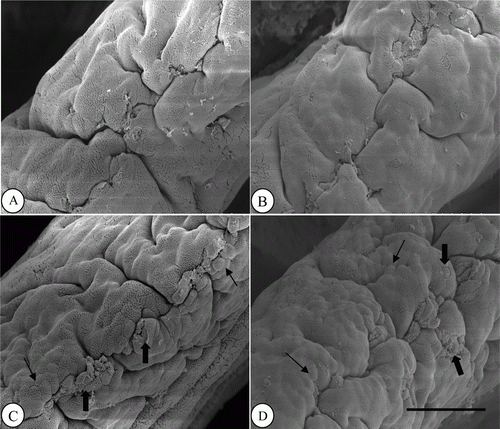
The control jejunal villus apical surface was distributed by comparatively flat epithelial cells, resulting in smooth surface (A). Almost similar smooth surface was also observed in 1 mg/kg HK-LP L-137 group (B). However, in 2 and 4 mg/kg HK-LP L-137 groups (C and D, respectively) protuberated cells (small arrows) and cells having no microvilli (large arrows) appeared.
Figure 4. Jejunal villus apical surface in chickens fed 0 (A), 1 (B), 2 (C) and 4 (D) mg/kg dietary HK-LP L-137. Small arrows, protuberated cells; Large arrows, cells having no microvilli. Scale bar=50 µm.
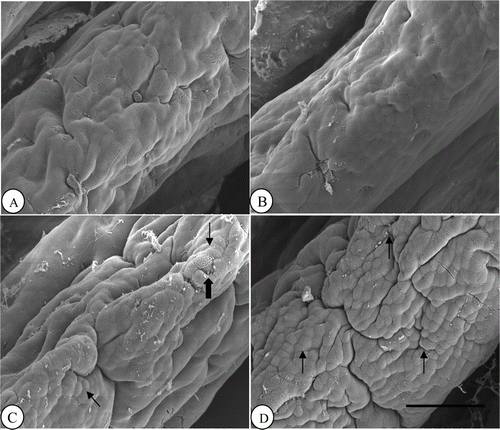
Ileal villus apical surface of the control (A) showed a faintly rough surface due to comparatively protuberated cells (arrow heads). However, 1, 2 and 4 mg/kg HK-LP L-137 groups (B–D, respectively) had many protuberated cells (arrows). As a characteristic feature, segmented filamentous bacteria were observed in all groups, but they were much number in all HK-LP L-137 groups ().
Figure 5. Ileal villus apical surface in chickens fed 0 (A), 1 (B), 2 (C) and 4 (D) mg/kg dietary HK-LP L-137. Arrow heads, comparatively protuberated cells; Arrows, protuberated cells. Scale bar=50 µm.
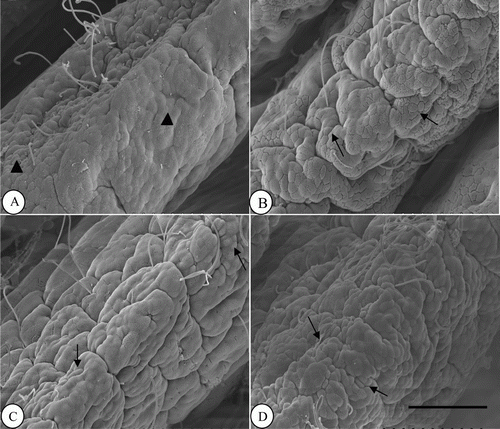
Table 3. Number of segmented filamentous bacteria within a square of 171×254 µm in the ileum in chickens dietary HK-LP L-137 (Mean±SE) (n=4).
Discussion
The HK-LP L-137® is effective for immunity (Murosaki et al. Citation1998). The intestine is direct organ for digestion, absorption and immunity. As the intestinal mucosa is continuously exposed to the ingested HK-LP L-137®, the latter was thought to affect also on intestinal histology. Although the light microscopic parameters did not change after feeding the dietary HK-LP L-137, cell mitosis numbers of the duodenum tended to be decreased in 1 mg/kg HK-LP L-137, but better in the 2 and 4 mg/kg HK-LP L-137 groups than the control. This variation was well correlated with scanning electron microscopic observations that the 1 mg/kg HK-LP L-137 group did not show a difference, but the 2 and 4 mg/kg HK-LP L-137 groups had many protuberant cells in all the intestinal segments than the control. Such increased cell mitosis number and protuberated cells on the villus apical surface were reported in chickens showing histologically hypertrophied intestine (Yamauchi et al. Citation2010), resulting in increased body weight (Khambualai et al. Citation2010). These studies suggest that the present intestine was also activated after feeding the dietary 2 and 4 mg/kg HK-LP L-137, resulting in a little higher body weight in these groups.
The ileum is known to contain a much larger population than another intestinal segment. Bacteria attachment to the ileal epithelial wall was a defense against the other undesirable bacterial colonisation from the cecum, or control ileal flora (Sarra et al. Citation1992). Lactobacillus acidophilus and Lactobacillus fermentum could not reduce the in vitro adherence of Salmonella enteritidis to the ileal epithelial cells (Jin et al. Citation1996). In the present ileum, segmented filamentous bacteria attaching to the epithelial cells were found in all groups. These bacteria were reported to contribute to growth rate by improving ileal function by attaching to epithelium (Yamauchi et al. Citation1990), and to be phagocytised into the ileal cells and intracellularly processed by lysosomal heterophagy (first triggering step for the intestinal immunological response (Yamauchi and Snel Citation2000). As the HK-LP L-137® is effective for immunity (Murosaki et al. Citation1998), the fact that much number of segmented filamentous bacteria were observed in the HK-LP L-137 groups suggest that HK-LP L-137® might affect on intestinal immunity by increasing these segmented filamentous bacteria.
In conclusion, the present 2 and 4 mg/kg HK-LP L-137 might activate intestinal function by increasing segmented filamentous bacteria, inducing a little better body weight gain.
References
- Amer , S , Na , KJ , El-Abasy , M , Motobu , M , Koyama , Y , Koge , K and Hirota , Y . 2004 . Immunostimulating effects of sugar cane extract on X-ray radiation induced immunosuppression in the chicken . International Immunopharmacology , 4 : 71 – 77 .
- Andremont , A . 2000 . Consequences of antibiotic therapy to the intestinal ecosystem . Annales Francaises d'Anesthesie et de Reanimation , 19 : 395 – 402 .
- Burgat , V . 1991 . Residues of drugs of veterinary use in food . La Revue du Praticien , 41 : 985 – 990 .
- El-Abasy , M , Motobu , M , Na , K-J , Shimura , K , Nakamura , K , Koge , K , Onodera , T and Hirota , Y . 2003a . Protective effects of sugar cane extracts (SCE) on Eimeria tenella infection in chickens . Journal of Veterinary Medical Science , 65 : 865 – 871 .
- El-Abasy , M , Motobu , M , Sameshima , T , Koge , K and Hirota , Y . 2003b . Adjuvant effects of sugar cane extracts (SCE) in chickens . Journal of Veterinary Medical Science , 65 : 117 – 119 .
- Han , IK , Lee , SC , Lee , JH , Lee , KK and Lee , JC . 1984 . Studies on the growth promoting effects of probiotics. 1. The effects of Lactobacillus sporogenes on the growing performance and the changes in microbial flora of the feces and intestinal contents of the broiler chicks . Korean Journal of Animal Science , 26 : 150 – 157 .
- Hirose , Y , Murosaki , S , Yamamoto , Y , Yoshikai , Y and Tsuru , T . 2006 . Daily intake of heat-killed Lactobacillus plantarum L-137 augments acquired immunity in healthy adults . The Journal of Nutrition , 136 : 3069 – 3073 .
- Jin , LZ , Ho , YW , Ali , MA , Abdullah , N and Jalaludin , S . 1996 . Effect of adherent Lactobacillus spp. on in vitro adherence of salmonellae to the intestinal epithelial cells of chicken . Journal of Applied Bacteriology , 81 : 201 – 206 .
- Kalbande , VH , Gaffar , MA and Deshmukh , SV . 1992 . Effect of probiotic and nitrofurin on performance of growing commercial pullets . Indian Journal of Poultry Science , 27 : 116 – 117 .
- Khambualai , O , Yamauchi , K , Ruttanavut , J , Incharoen , T and Kashimura , J . 2010 . Effect of sugar cane extract, commercial probiotic and their mixture on growth performance and intestinal histology in broiler chickens . American Journal of Animal and Veterinary Sciences , 5 : 132 – 138 .
- Maeda , N , Nakamura , R , Hirose , Y , Murosaki , S , Yamamoto , Y , Kase , T and Yoshikai , Y . 2009 . Oral administration of heat-killed lactobacillus plantaram L-137 enhances protection against influenza virus infection by stimulation of Type I interferon production in mice . International Immunopharmacology , 9 : 1122 – 1125 .
- Maiolino , R , Fioretti , A , Menna , F and Meo , C . 1992 . Research on the efficiency of probiotics in diets for broiler chickens . Nutrition Abstract and Review Series B , 62 : 482
- Murosaki , S , Muroyama , K , Yamamoto , Y and Yoshikai , Y . 2000 . Antitumore effect of heat-killed Lactobacillus plantarum L-137 through restoration of impaired interleukin-12 production in tumore-bearing mice. Cancer Immunology . Immunotherapy , 49 : 157 – 164 .
- Murosaki , S , Yamamoto , Y , Ito , K , Inokuchi , T , Kusaka , H , Ikeda , H and Yoshikai , Y . 1998 . Heat-killed Lactobacillus plantarum L-137 suppresses naturally fed antigen-specific IgE production by stimulation of IL-12 production in mice . Journal of Allergy and Clinical Immunology , 102 : 57 – 64 .
- Olympia , M , Ono , H , Shinmyo , A and Takano , M . 1992 . Lactic acid bacteria in a fermented fishery product, “Burong Bangus” . Journal of Fermentation and Bioengineering , 73 : 193 – 197 .
- Sarra , PG , Morelli , L and Bottazzi , V . 1992 . “ The lactic acid microflora of fowl ” . In The lactic acid bacteria. Vol. 1. The lactic acid bacteria in health and disease , Edited by: Wood , BJB . 3 – 21 . London , , UK : Elsevier Applied Science .
- Sorum , H and Sunde , M . 2001 . Resistance to antibiotics in the normal flora of animals . Veterinary Research , 32 : 227 – 241 .
- Tortuero , F . 1973 . Influence of implantation of Lactobacillus acidophilus in chicks on the growth, feed conversion, malabsorption of fats syndrome and intestinal flora . Poultry Science , 52 : 197 – 203 .
- Watkins , BA and Kratzer , FH . 1983 . Effect of oral dosing of Lactobacillus strains on gut colonization and liver biotin in broiler chicks . Poultry Science , 62 : 2088 – 2094 .
- Watkins , BA and Kratzer , FH . 1984 . Drinking water treatment with commercial preparation of a concentrated Lactobacillus culture for broiler chickens . Poultry Science , 63 : 1671 – 1673 .
- Yamauchi , K , Buwjoom , T , Koge , K and Ebashi , T . 2006 . Histological alterations of the intestinal villi and epithelial cells in chickens fed dietary sugar cane extract . British Poultry Science , 47 : 544 – 553 .
- Yamauchi , K , Incharoen , T and Yamauchi , K . 2010 . The relationship between intestinal histology and function as shown by compensatory enlargement of remnant villi after midgut resection in chickens . The Anatomical Record , 293 : 2071 – 2079 .
- Yamauchi , K , Isshiki , Y , Zhou , Z-X and Nakahiro , Y . 1990 . Scanning and transmission electron microscopic observations of bacteria adhering to ileal epithelial cells in growing broilers and White Leghorn chickens . British Poultry Science , 31 : 129 – 137 .
- Yamauchi , K and Snel , J . 2000 . Transmission electron microscopic demonstration of phagocytosis and intracellular processing of segmented filamentous bacteria by intestinal epithelial cells of the chicken ileum . Infection and Immunity , 68 : 6496 – 6504 .
